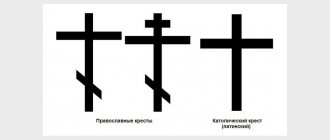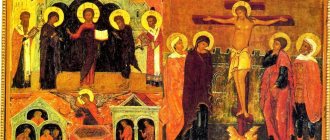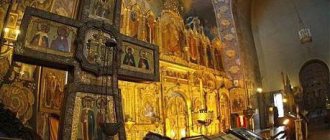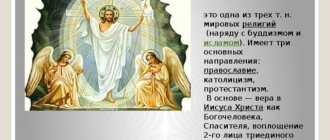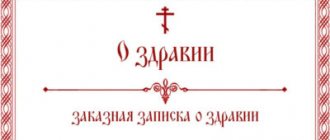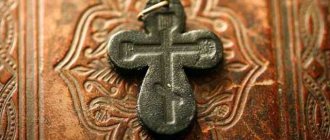More than three centuries have passed since the church schism of the 17th century, and most still do not know how the Old Believers differ from Orthodox Christians. Do not do it this way.
Terminology
The distinction between the concepts of “Old Believers” and “Orthodox Church” is quite arbitrary. The Old Believers themselves admit that their faith is Orthodox, and the Russian Orthodox Church is called New Believers or Nikonians.
In the Old Believer literature of the 17th - first half of the 19th centuries, the term “Old Believer” was not used.
Old Believers called themselves differently. Old Believers, Old Orthodox Christians...The terms “orthodoxy” and “true Orthodoxy” were also used.
In the writings of Old Believer teachers of the 19th century, the term “true Orthodox Church” was often used. The term “Old Believers” became widespread only towards the end of the 19th century. At the same time, Old Believers of different agreements mutually denied each other’s Orthodoxy and, strictly speaking, for them the term “Old Believers” united, on a secondary ritual basis, religious communities deprived of church-religious unity
Story
The term “Old Believers” was formed in the early fifties of the seventeenth century. During this period, Moscow Patriarch Nikon, with the support of Tsar Alexei Mikhailovich, began to reform the Russian Orthodox Church. The changes began with the transition from Russian to Greek church charter - church books began to be brought into line with the Greek canons. The order of services began to change. “Amendments” were made to ritual actions. Such innovations caused protest among a significant part of society, consisting of the clergy, boyars, and common people.
The supporters of the old rituals were led by Archpriest Avvakum. The protesters refused to accept the reforms and called for a return to the original Russian Orthodox order. The authorities persecuted them, which led to the death of a large number of people - public reprisals, executions. In addition to physical violence, the Old Believers suffered moral oppression. By the tsar's decrees, unaffordable taxes were imposed on them, and it was forbidden to engage in agriculture and cattle breeding. The authorities turned a blind eye to the criminal actions against the Old Believers on the part of the “consenting” population - their food supplies were destroyed, their huts were burned, and they were deprived of their lives.
Such actions forced the Old Believers to leave their native lands and settle in remote areas. This is how Old Believer settlements appeared, where people devoted to their faith lived in accordance with its rules.
The situation changed with the coming to power of Peter the Great - he canceled the cruel decrees, the persecution stopped. However, the life and rights of the Old Believers were semi-legal:
- Old Believers were prohibited from holding high positions;
- baptism according to the old faith was not recognized by the current church;
- marriages entered into by Old Believers were considered illegal;
- Children born in such marriages were considered illegitimate.
Only towards the end of the 18th century did the “top leadership” realize that the ritual differences that caused the schism of the Russian Orthodox Church were insignificant. This is how Unity of Faith appeared.
Almost two million people of the old faith live in modern Russia. It is clear that now they are not oppressed, they are free to live wherever they want, and have equal rights with other citizens.
Fingers
It is well known that during the schism the two-finger sign of the cross was changed to three-finger. Two fingers are a symbol of the two Hypostases of the Savior (true God and true man), three fingers are a symbol of the Holy Trinity.
The three-finger sign was adopted by the Ecumenical Orthodox Church, which by that time consisted of a dozen independent Autocephalous Churches, after the preserved bodies of the martyrs-confessors of Christianity of the first centuries with folded fingers of the three-finger Sign of the Cross were found in the Roman catacombs. There are similar examples of the discovery of the relics of saints of the Kiev Pechersk Lavra.
How Old Believers are baptized
In Orthodoxy, it is customary to make the sign of the cross with three fingers—three fingers, symbolizing the unity of the Holy Trinity.
Old Believers cross themselves with two fingers, as was customary in Rus', saying “Alleluia” twice and adding “Glory to Thee, God.”
For worship they dress in special clothes: men put on a shirt or blouse, women wear a sundress and a scarf. During the service, Old Believers cross their arms over their chests as a sign of humility before the Almighty and bow to the ground.
Jesus
During the Nikon reform, the tradition of writing the name “Jesus” was changed. The double sound “and” began to convey the duration, the “drawn-out” sound of the first sound, which in the Greek language is indicated by a special sign, which has no analogy in the Slavic language, therefore the pronunciation of “Jesus” is more consistent with the Universal practice of sounding the Savior. However, the Old Believer version is closer to the Greek source.
Why were the Old Believers called Bespopovtsy?
The split of the Old Believers formed two separate branches - priesthood and non-priesthood. Unlike the Old Believers-Priests, who after the schism recognized the church hierarchy and all the sacraments, the Old Believers-Priestless began to deny the priesthood in all its manifestations and recognized only two sacraments - Baptism and Confession.
There are Old Believer movements that also do not deny the sacrament of Marriage. According to the Bespopovites, the Antichrist has reigned in the world, and all modern clergy is a heresy that is of no use.
Differences in the Creed
During the “book reform” of the Nikon reform, changes were made to the Creed: the conjunction-opposition “a” was removed in the words about the Son of God “born, not made.”
From the semantic opposition of properties, a simple enumeration was thus obtained: “begotten, not created.”
The Old Believers sharply opposed the arbitrariness in the presentation of dogmas and were ready to suffer and die “for a single az” (that is, for one letter “a”).
In total, about 10 changes were made to the Creed, which was the main dogmatic difference between the Old Believers and the Nikonians.
Why not three-fingered?
Usually believers of other faiths, for example, New Believers, ask why Old Believers do not cross themselves with three fingers, like members of other Eastern churches.
On the left is the three-fingered sign; this sign of the cross was adopted by the New Believer tradition. On the right is two fingers, the Old Believers sign themselves with this sign of the cross
The following can be answered:
- Double-fingering was commanded to us by the apostles and fathers of the ancient Church, for which there is a lot of historical evidence. The three-fingered ritual is a newly invented ritual, the use of which has no historical justification;
- The keeping of two fingers is protected by a church oath, which is contained in the ancient rite of acceptance from heretics by Jacobite and the decrees of the Council of the Hundred Heads in 1551: “ If anyone does not bless with two fingers as Christ did, or does not imagine the sign of the cross, let him be damned ”;
- The two-fingered sign reflects the true dogma of the Christian Creed - the crucifixion and resurrection of Christ, as well as the two natures in Christ - human and Divine. Other types of the sign of the cross do not have such dogmatic content, but the three-fingered sign distorts this content, showing that the Trinity was crucified on the cross. And although the New Believers do not contain the doctrine of the crucifixion of the Trinity, St. the fathers categorically prohibited the use of signs and symbols that have heretical and non-Orthodox meaning. Thus, polemicizing with Catholics, the holy fathers also pointed out that the mere change in the creation of a species, the use of customs similar to heretical ones, is in itself a heresy. Ep. Nikolas of Methonsky wrote, in particular, about unleavened bread: “Whoever consumes unleavened bread is already suspected of communicating with these heresies because of some similarity.” The truth of the dogmatics of two fingers is recognized today, although not publicly, by various New Believer hierarchs and theologians. So oh. Andrey Kuraev in his book “Why the Orthodox are like this” points out: “I consider two-fingered to be a more accurate dogmatic symbol than three-fingered. After all, it was not the Trinity that was crucified, but “one of the Holy Trinity, the Son of God . ”
Question of the cross
Old Believers recognize only the eight-pointed cross, while after Nikon’s reform in Orthodoxy four and six-pointed crosses were recognized as equally honorable. On the crucifixion tablet of the Old Believers it is usually written not I.N.C.I., but “King of Glory.” Old Believers do not have an image of Christ on their body crosses, since it is believed that this is a person’s personal cross.
Pectoral crosses of Pomeranian types from the 18th – early 20th centuries. History, chronology, classification.
In this paper we will talk about two categories of Old Believer pectoral crosses, which were widespread in the late 18th - early 20th centuries. Crosses of the first category are shaped like an oak leaf, which is why they have the colloquial name “leaves”; the second category is four-pointed crosses with straight wide blades (“late straight-pointed”). Despite the mass production and its chronological proximity to modern times, this topic has been practically unstudied. The proposed work is, so to speak, only a “test of the pen” in the field of studying, dating and systematizing the varieties of these categories of pectoral crosses.After the decrees of Peter I “On the prohibition of using carved and cast icons in church and private houses” (1722) and the Holy Synod on the prohibition of the production and sale of cast icons (1723), this area of activity was officially recognized as illegal. However, the Old Believer communities ignored the above-mentioned decrees, thanks to which they remained a monopoly in this form of art over the next two centuries. One of the first major casting centers in the 18th century. became Pomorie, and first of all the Vygovskaya monastery with all the adjacent graveyards and monasteries. In 1695, the clerk Daniil Vikulov (which is why the later monastery had a second name - Danilov) in the Povenets district of the Olonets province, on the Vyg River, an Old Believer community was founded. The Vygov hostel quickly grew and developed. It taught icon painting, set up bookbinding and leather workshops, introduced silk and gold embroidery, and developed wood carving. Due to the large influx of people in 1706, the hostel was divided into the Vygovsky male and female Lexinsky monasteries.
In 1703, the government made some concessions, but the monks of the monastery were assigned to the state metallurgical plants in Povenets. Thanks to this, they managed to master the technique of copper casting and by the end of the first quarter of the 18th century. to begin production of cast crosses and icons at the monastery. However, to protect the old faith, it was necessary to create our own shrines, including body crosses, which would become an organic continuation of ancient traditions in this area of spiritual culture. And such crosses were created. They became a male straight-pointed cross with wide blades and a female cross in the shape of a leaf.
If the severity of the male cross was quite in the spirit of the Old Believers, then the bizarre patternedness of the female “leaf” raises questions. The origins of the appearance of such a form, apparently, should be sought in the Vygov wood carvings and book printing, which were practiced in Pomerania even before the start of copper foundry. So, the semantics of such a cross, carved from cypress, is quite clear - it is a leaf of the Tree of Life. Cypress in Christianity is a symbol of incorruptibility, perseverance and valor, one of the trees from which the Cross of the Lord was created. At the same time, in the baroque frame that seems at first glance, analogies with the floral ornamentation of the Pomeranian books are clearly visible, more reminiscent of the “marking grasses” of the late 16th century than the baroque (Fig. 1).
Speaking about wood carving, one cannot fail to note the existence of so-called “hollow” crosses, male and female. Their appearance is associated with the high cost of cypress wood and its low availability for ordinary people. For him, icons and crosses were cut from linden and tinted to look like cypress (hence “linden” is a fake). The masters of the Vygov monastery came up with a way to use waste from carving cypress products. They made “hollow” metal crosses, which were filled inside with thin cypress chips. It should be noted that the cypress confirmed its incorruptibility. In such crosses recently found in Pomorie, the cypress filling was not damaged (Fig. 2, 1), despite the fact that they had been in the ground for at least one hundred and fifty years. A completely different picture is presented by the crosses that were filled with linden (Fig. 2, 2, 3). It is difficult to say whether the “hollow” crosses served as prototypes for later all-metal crosses or existed in parallel. Let us add that “hollow” crosses were also found in other regions, but they are quite rare there.
We cannot ignore another rarely encountered type of cross, its outline resembling a “leaf” and representing a late version of the crosses “with radiance” of the second half of the 17th century. This is an openwork straight-pointed cross with three-part completion of the branches and radiance around the middle cross (Fig. 2, 4). The upper rays of radiance end in balls, the lower ones smoothly bend towards the lower extremity and, touching it, end in a curl. Apparently, only in the 19th century. on pectoral crosses of Pomeranian casting there appears a head made in the form of a bead with three crowns at the top. This type of table of contents gained the greatest popularity throughout Russia by the end of the 19th century. and, according to the testimony of the masters of that time, symbolized the Holy Trinity (1). Some of the tabletops on crosses made by Pomeranian craftsmen were decorated with rhombuses (Fig. 2, 5) or vertical lines (Fig. 2, 6).
The types of pectoral crosses developed in Pomorie became models for Old Believer workshops throughout Russia, since the work of the Vygov masters was always distinguished by high quality and grace.
The closest contacts with the Pomeranians were maintained by the Fedoseyevskaya community of Old Believers, which had significant weight in Moscow. In 1771, during a pestilence, the frightened authorities allowed the Moscow Fedoseevites to build a chapel and cemetery near the village of Preobrazhenskoye, supposedly to organize a plague quarantine. In fact, an almshouse was opened here, and Old Believers began to populate the area around the cemetery. From this moment, based on the theoretical and practical experience of Pomeranian craftsmen, the production of Old Believer casting began in Moscow. At a joint council of Pomeranians and Fedoseevites, held in St. Petersburg in 1791, an agreement was reached on the controversial issue of the inscription on the cross. The Fedoseevites abandoned the writing of the title “ INCI ”, which they had advocated until now, and returned to the more ancient inscription “ TSS IX NIKA ”. From that moment on, Pomeranian crosses began to be made in Moscow. Thus, the last decade of the 18th century can be considered the lower limit of the appearance of the described categories of crosses in Central Russia. This is confirmed by statistics. A survey of local history searchers showed that cases of finds of “leaves” and “late straight-pointed” crosses in settlements that ceased to exist before the 1790s are rare. They are easily explained either by late losses or by rare Vyg specimens. At the same time, in settlements that disappeared before the mid-19th century, the number of such crosses is 50% or more. And this is not surprising: by that time, Moscow “copper establishments” were already playing a leading role in the production of Christian plastic, supplying the whole of Russia with “Pomeranian” castings produced in Moscow (2).
An interesting example is the Ryazan province, which was supplied with Moscow cast crosses. The centers of trade were the city of Kasimov, the village of Korovka, Sapozhkovsky district, etc. Crosses were sold in special shops, and at the beginning of the 20th century. and in temples. Particularly revered were the “leaves”, which were considered feminine. Pregnant women in the village of Lubonos had to wear just such a cross: it was like a talisman for the unborn child. According to the tradition of including crosses in necklaces, dating back to pre-Mongol times, the women of the village of Tarnovo used “leaves” for these purposes, placing the largest one in the center. And men treated this type of crosses with respect, sometimes including them in rosaries and belts (“ropes”). This indirectly confirms the semantics of the “leaf” as part of the cypress tree - a symbol of valor. Sometimes crosses were kept in the red corner “behind the icons.”
No later than the second quarter of the 19th century. the production of copper-cast plastic appears in Zagarye (14 villages in the Novinskaya volost of the Bogorodsky district of the Moscow province), Guslitsy (several villages along the Guslitsa River in the Ilyinskaya volost of the Bogorodsky district of the Moscow province) and in the village of Nikologorsky pogost of the Vyaznikovsky district of the Vladimir province, 25 versts from Mstera.
Zagar cast products were of the lowest quality. They were distinguished by the absence of filing, significant weight and the rare use of enamels (3). Zagarskaya products were sold for 18–22 rubles per pood, while the price of copper was 10 rubles per pood.
The Guslitsky casting was better than the Zagar casting and sold at a price of 30–38 rubles per pood. It is characterized by light weight and the use of white and blue enamels (3). Relatively good quality and low price made Guslitsky products quite popular throughout the 19th and 20th centuries.
The craftsmen who worked in the Nikologorsk Pogost were engaged in copying products from other centers, as well as counterfeiting ancient plastic art (4).
It should be noted that the pectoral crosses of the earliest examples, found in the settlements of the Ryazan province, which disappeared before the mid-19th century, have a head in the form of an ear (Fig. 2, 7, 8).
Despite the repressions of the mid-19th century, the production of plastic materials in Moscow did not stop. At the end of the 19th - beginning of the 20th century. The most famous Old Believer workshops of artistic copper casting were the establishments of F.G. Pankratova and M.I. Sokolova. The works of Moscow masters were distinguished by high quality, increased decorativeness and the use of multi-color enamels. Their products, unlike other manufacturers, were sold “not by weight, but by count.”
At the turn of the 19th–20th centuries. Old Believer copper casting is becoming a mass phenomenon. In addition to the expansion of production in the above centers, new centers are emerging. One of them was the Krasnoselskaya volost of the Kostroma province (5). Krasnoselsky masters mostly copied samples from Moscow workshops. Crosses were cast mainly from brass, which, apparently, was typical for Moscow production at that time. A distinctive feature was the use of dark blue transparent, as well as blue and white solid enamels. From the memoirs of the Krasnoselsky foundry master (1) we know that, in addition to dividing crosses into male and female, they had several “grades” depending on size. The quality of the crosses was quite high and were sold individually. They were sold to wholesalers at prices:
Infant, 22.5x10(2.5) mm (Fig. 3, 1) - 1 kopeck per piece; for children, 36x18(2.5) mm (Fig. 3, 2, 4) – 1.5 kopecks each; medium, 41x22(2.5) mm (Fig. 3, 3, 5) – 2.5 kopecks each; large, 47x25(2.5) mm (Fig. 3, 6) – 3.5 kopecks each; the largest, more than 52x38 mm (Fig. 3, 7) – 5 kopecks each. Thus, crosses cost on average 62–82 rubles per pood, while the cost of brass was about 9 rubles per pood. The price for Moscow products was apparently about the same. However, the pectoral crosses of the categories under consideration differed not only in size. Analysis of the entire set of finds of such crosses, provided by local history searchers, made it possible to identify a number of important compositional differences.
The female cross differs from the male one in that the four-pointed cross underlying the composition is framed with floral patterns. The iconography of the four-pointed crosses themselves is similar, both on the front and back sides. All four-pointed crosses on the front side depict a relief eight-pointed Calvary Cross. The short crossbar of the Calvary Cross depicts a tablet “with the inscription of guilt,” nailed over the head of the Savior by order of Pontius Pilate. The slanting crossbar was nailed under the feet of Christ. Below it, at the foot of the Cross, in a cave, is depicted the Head of Adam, buried, according to legend, exactly in the place where Christ was subsequently crucified. On the sides of the Cross are depicted a copy of the centurion Longinus and a cane with a sponge.
The field around the cross is usually filled with inscriptions, among which the following options have been identified:
1. Above the Calvary Cross - Ts S under the title. On the sides of the Cross there is IC XC under the titles (Fig. 3, 1). 2. Above the Cross - YOUR KING in two lines under the titles. On the sides of the Cross there is IC XC under the titles (Fig. 3, 3). 3. Above the Cross - THE KING OF THE LORD in two lines under the titles. On the sides of the Cross there are monograms: above the main crossbar - IC XC under the titles, below it - SNЪ BZHII under the titles (Fig. 3, 2). The largest and largest crosses have the monogram NIKA (Fig. 3, 7). 4. Above the Cross is the inscription TsR SLVA in two lines under the titles. On the sides of the Cross there are monograms: above the main crossbar - IC XC under the titles, below it - NI KA or NIKTKA . 5. Above the Cross are the monograms Ts S , IC XC and S B in three lines under the titles. Above the main crossbar of the Cross is CRUCIFIED , below it is an illegible inscription (Fig. 3, 5). 6. Above the Cross - monograms Ts S and I X in two lines. On the sides of the Cross there are monograms: above the main crossbar - G and B , below it - M and L (Fig. 3, 4). Here is the KING OF Glory , Ts S – the King of Glory; IC XC – Jesus Christ; SNЪ BZHII , S B – Son of God; NIKA – Winner; NIKTKA – Winner, Spear, Cane; GB – Golgotha Byst; M L – Place Lobno. The first option is found only on infant crosses. The second option was identified on crosses for children and middle-aged children. The fifth option is typical only for middle crosses. The sixth option is found only on men's crosses. On the reverse side, the entire field inside the straight-pointed cross is occupied by text. Three main options were identified: 1. May God rise again and His enemies will be scattered... (Fig. 3, 1, 6). 2. Lord, Jesus Christ, Son of God, bless, and sanctify, and preserve me by the power of Your Life-Giving Cross (Fig. 3, 2–5). 3. We worship Your Cross, Master, and we glorify Your holy Resurrection (Fig. 3, 7). The second version of the inscription is typical only for children's and middle grades; the third is relatively rare.
This work proposes the very first, approximate schemes of the chronology and classification of two common categories of late body crosses. But the author hopes that they will also be useful to museum workers and private collectors. Literature: 1. About the history of the foundry of icons and crosses of the copper foundry establishment of Pyotr Yakovlevich Serov (1899–1974) - Russian copper casting. Vol. 2. M., 1993. 2. Zotova E.Ya. Pomeranian copper-cast plastic: on the history of formation and development in the Moscow region - Local traditions in the folk culture of the Russian North. Materials of the IV scientific conference “Ryabinin Readings - 2003”. Collection of scientific reports. Petrozavodsk. 2003. 3. Zotova E.Ya. Guslitsky and Zagarsky copper casting. The problem of classification - Report at the interregional scientific and practical conference dedicated to the 75th anniversary of the Orekhovo-Zuevsky district. 2004 4. Savina L.A. To the history of the production and existence of copper artistic casting in the 19th - early 20th centuries - Russian copper casting. Vol. 1. M., 1993. 5. Kukolevskaya O.S. Copper artistic casting of the Krasnoselskaya volost of the Kostroma province at the end of the 19th - beginning of the 20th century - Russian copper casting. Vol. 1. M., 1993.
Author: Vasily Korshun - Member of the Union of Local Lore of Russia
Dear old man. 2009. No. 2. pp. 36–41.
A deep and powerful Hallelujah
During Nikon's reforms, the pronounced (that is, double) pronunciation of “halleluia” was replaced by a triple (that is, triple). Instead of “Alleluia, alleluia, glory to you, God,” they began to say “Alleluia, alleluia, alleluia, glory to you, God.”
According to New Believers, the triple utterance of alleluia symbolizes the dogma of the Holy Trinity.
However, Old Believers argue that the strict pronunciation together with “glory to Thee, O God” is already a glorification of the Trinity, since the words “glory to Thee, O God” are one of the translations into the Slavic language of the Hebrew word Alleluia (“praise God”).
Customs and traditions of the Old Believers
The current way of life of the Old Believers is practically no different from the one that their grandfathers and great-grandfathers used several centuries ago. In such families, history and traditions are respected, passed down from generation to generation. Children are taught to respect their parents, brought up in strictness and obedience, so that in the future they become a reliable support.
From a very early age, sons and daughters are taught to work, which is held in high esteem by the Old Believers. They have to work a lot: Old Believers try not to buy food in the store, so they grow vegetables and fruits in their gardens, keep livestock in perfect cleanliness, and do a lot of things for the house with their own hands.
They do not like to talk about their lives to strangers, and even have separate dishes for those who come into the community “from the outside.”
To clean the house, use only clean water from a blessed well or spring. The bathhouse is considered an unclean place, so the cross must be removed before the procedure, and when they enter the house after the steam room, they must wash themselves with clean water.
Old Believers pay great attention to the sacrament of baptism. They try to baptize the baby within a few days after his birth. The name is chosen strictly according to the calendar, and for a boy - within eight days after birth, and for a girl - within eight days before and after birth.
All attributes used in baptism are kept in running water for some time so that they become clean. Parents are not allowed to attend christenings. If mom or dad witnesses the ceremony, then this is a bad sign that threatens divorce.
As for wedding traditions, relatives up to the eighth generation and relatives “on the cross” do not have the right to walk down the aisle. There are no weddings on Tuesday and Thursday. After marriage, a woman constantly wears a shashmura headdress; appearing in public without it is considered a great sin.
Old Believers do not wear mourning. According to customs, the body of the deceased is washed not by relatives, but by people chosen by the community: a man is washed by a man, a woman by a woman. The body is placed in a wooden coffin with shavings at the bottom. Instead of a lid there is a sheet. At funerals, the deceased is not remembered with alcohol, and his belongings are distributed to the needy as alms.
Bows at the service
At services in Old Believer churches, a strict system of bows has been developed; replacing prostrations with bows from the waist is prohibited. There are four types of bows: “regular” - bow to the chest or to the navel; “medium” - in the waist; small bow to the ground - “throwing” (not from the verb “to throw”, but from the Greek “metanoia” = repentance); great prostration (proskynesis).
Throwing was banned by Nikon in 1653. He sent out a “memory” to all Moscow churches, which said: “It is not appropriate to do throwing on your knees in church, but you should bow to your waist.”
Old Believers - who are they?
Old Belief arose in the 17th century as a protest against changes in old church customs and traditions. A schism began after the reforms of Patriarch Nikon, who introduced innovations in church books and church structure. All who did not accept the changes and advocated for the preservation of old traditions were anathematized and persecuted.
The large community of Old Believers soon split into separate branches that did not recognize the sacraments and traditions of the Orthodox Church and often had different views on the faith.
Avoiding persecution, the Old Believers fled to uninhabited places, settling in the North of Russia, the Volga region, Siberia, settling in Turkey, Romania, Poland, China, reaching Bolivia and even Australia.
Beads
Orthodox and Old Believer rosaries are different. Orthodox rosaries can have a different number of beads, but most often rosaries with 33 beads are used, according to the number of earthly years of Christ’s life, or a multiple of 10 or 12.
In the Old Believers of almost all agreements, the lestovka is actively used - a rosary in the form of a ribbon with 109 “beans” (“steps”), divided into unequal groups. Lestovka symbolically means a ladder from earth to heaven.
The departure of the Old Believers from the official church
In the middle of the 17th century, the Russian Orthodox Church experienced a severe shock caused by the reform carried out by its primate, Patriarch Nikon. Despite the fact that the reform affected only the external ritual side of worship, without touching the main thing - religious dogma, it led to a schism, the consequences of which have not been smoothed out to this day.
It is known that, having entered into irreconcilable contradictions with the official church and separated from it, the Old Believers did not remain a single movement for long. The disagreements that arose between its religious leaders caused it to soon split into dozens of groups called “talks” and “concords.” Each of them was characterized by its own Old Believer cross.
Pilate's inscription
Often the reason for disputes is the text of the inscription on the upper, small crossbar. It is known from the Gospel that the inscription on the tablet attached to the cross of the Savior was made by Pontius Pilate, by whose order Christ was crucified. In this regard, the Old Believers have a question: is it worthy for the Orthodox Old Believer cross to bear an inscription written by one who is forever cursed by the church? Its most ardent opponents have always been the above-mentioned Pomeranians and Fedoseevites.
It is curious that disputes over the “Pilate inscription” (as the Old Believers call it) began in the first years of the schism. One of the prominent ideologists of the Old Believers, Archdeacon of the Solovetsky Monastery Ignatius, is known for having compiled several very voluminous treatises condemning this title, and even submitted a petition about this to the sovereign Alexei Mikhailovich himself. In his writings, he argued that such an inscription was inadmissible and urgently demanded that it be replaced with the abbreviation of the inscription “Jesus Christ King of Glory.” It would seem like a minor change, but there was a whole ideology behind it.
The cross is a common symbol for all Christians
Nowadays, when the official church has recognized the legitimacy and equality of the Old Believer Church, in Orthodox churches you can often see the same crosses that previously existed only in schismatic monasteries. This is not surprising, since we have one faith, the Lord is one, and asking the question of how the Old Believer cross differs from the Orthodox cross seems incorrect. They are essentially united and worthy of universal worship, since, despite minor external differences, they have common historical roots and equal grace-filled power.
The Old Believer cross, the difference from the usual one, as we found out, is purely external and insignificant, is rarely an expensive piece of jewelry. Most often, he is characterized by a certain asceticism. Even the Old Believer golden cross is not common. Most of them are made from copper or silver. And the reason for this is not at all in economy - among the Old Believers there were many wealthy merchants and industrialists - but rather in the priority of internal content over external form.
